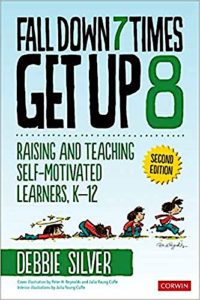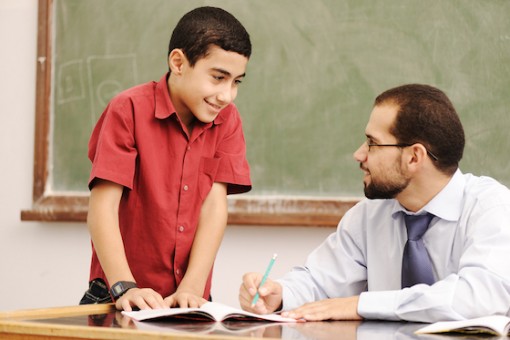Empowering Our Kids to Motivate Themselves
Now more than ever we need to foster self-initiation, self-efficacy, and resilience in our young people.
Because I am passionate about the study of motivation, I often get asked the question, “In today’s world how do I motivate these kids?” My short answer is just two words, “You can’t.”
Think about it – motivation is intrinsic. It is initiated from within an individual and not from outside them. Drive is not something an enthusiastic adult can transfer to an uninspired learner. It doesn’t work like that. Motivation is self-activated and must be cultivated from within.
Perhaps the better question to ask is, “How do we encourage learners to motivate themselves?” Using the term self-motivation reminds us the whole goal is to help learners ignite themselves with an internal voice that says, “I am a self-directed person who has power over my choices and my actions. I can affect positive changes in my life if I work for them.”
During the recent shift in learning platforms from face-to-face to virtual many teachers discovered unsettling weaknesses in our learners’ abilities to be self-directed and to set their own learning goals outside a highly structured classroom.
One of our takeaways from the isolation caused by the pandemic has got to be that now more than ever we need to foster self-initiation, self-efficacy, and resilience in our young people. Easier said than done, right?
How can we stimulate kids who already feel helpless or advance learners who feel they are somehow entitled? What are the magic words or pictures that encourage people to keep moving forward even in the face of disappointment or doubt?
The truth is that positive posters, one-shot inspirational speeches, and other superficial patches may be great reminders, but until we change the mindset of a learner, there is little chance for their genuine growth.
It takes hard work to inspire self-reliant learners. Perhaps we should start with better nurturing autonomy and improving the feedback we give students.
Kids Need More Autonomy in Their Learning
These past months have highlighted the problem that many students had no idea how to proceed without the direct supervision of a teacher. We tell students we want them to become independent, lifelong learners, but do we really model that?
In classrooms where students are praised for following restrictive guidelines, for learning in the “preferred” way, for being the first to complete a task, or for easy mastery, aren’t learners being taught compliance rather than resourcefulness? If every aspect of their learning has been explicitly spelled out for them, why are we surprised that when teachers are no longer in direct proximity to students, many of the students are clueless about what to do next.
I think the recent lockdown provided a wake-up call about the need for building self-determination skills in our kids. We need to move away from placing more importance on checking boxes and adhering to pacing guides than we do on building autonomous learners who are unafraid to use their own resources to learn new things. We need to communicate better to students that humans have the ability to get better at anything they choose through focused effort and effective choices.

Rather than try to “motivate” them with grades, words, and extrinsic rewards, we can make sure as teachers we celebrate individual growth rather than commend only the top performances. We can center our praise more on incremental steps forward and less on fixed levels of achievement. In short, we can:
1. Discuss with and guide learners in how to decide “next steps” on any assignment.
2. Purposefully provide learning options that give students more freedom to choose what works best for them.
3. Model using retrieval practice to help students assess their own learning and plan next moves.
4. Help students keep records of their personal growth and focus on gains more than just meeting standards.
5. Reduce extrinsic rewards as much as possible and concentrate on cultivating the intrinsic joy of genuine accomplishment.
6. Create a classroom culture that purposefully enhances each student’s healthy sense of self.
Effective Feedback Is Essential
I’ve worked with students for several decades. People often question, “Do you think kids are different today than in the past?” My answer is “No.” I don’t think kids have changed – I think the world they live in has changed.
And what I see today is what I’ve always seen with young learners; kids crave the undivided, focused attention of the adults in their lives. They want to show us what they can do, and they want our genuine interest and specific comments on how they can improve. Adults who take notice, take time, and demonstrate a positive attitude help learners build strong internal voices they can follow even when the adults aren’t present.
Constructive feedback is one of the most essential elements for enhancing self-motivation in learners. I have to admit that learning to give better feedback has been something I have worked on since I first started teaching.
In the beginning I made many mistakes. I overpraised, I made exaggerated leaps predicting epic outcomes for students, and I overused global interjections (“Awesome!” “You’re Number 1!” “You’re a Superstar!”) that either gave my students a sense of entitlement or negated my credibility entirely. My unfounded, effusive “rah-rah’s” did little to help my students improve.
The purpose of feedback is to provide instructive knowledge that will enhance a learner’s performance. It should be helpful in that it informs them about their progress. It should not judge, label, accuse, excuse, or excessively praise.
The ultimate goal is to create positive change in the student rather than merely improve the work itself. I’ve worked hard to make sure my feedback to learners is honest, specific, nonjudgmental and given for the express purpose of helping a student grow in a positive way.
An additional caveat I’ve learned since I left the classroom is that feedback should be focused solely on things the student can control.
Current researchers such as Albert Bandura, Carol Dweck, John Hattie, and others admonish us to stop praising students for such points as intelligence, physical beauty, innate talents, or any nature-derived characteristics. In order to empower students, we must limit our suggestions to things they can control (choices, efforts, strategies, tenacity, courage, inventiveness, resourcefulness, etc.)
We can help learners maintain their momentum by pointing out their role in their successful progress towards their goals. We can treat task completion as a work in progress rather than a finite goal with an inflexible timeline. To be effective, feedback needs to:
1. Be timely. The closer the feedback is given to the completion of the task, the more meaning it has for the learner.
2. Be attentive. Limit distractions when giving verbal feedback. Make sure written feedback is legible and easy to understand.
3. Be straightforward. Share data from student work. Be candid, calm, and matter-of fact.
4. Use descriptive language. Use precise terms that leave little room for misinterpretation.
5. Be positive. Let the learner know what they did well and also what they almost did well. Communicate your belief the learner can reach their goal.
6. Offer autonomy. Encourage the learner to offer their own ideas about how they can improve.
7. Use observations, not inferences. Reflections should be objective and factual. Stay away from assumptions or assigning motives to the learner.
8. Avoid feedback overload. Too much feedback at once can cause the learner to become disengaged, confused, or discouraged. Less is better.
Helping students to become independent, self-directed learners requires educators (as well as parents and guardians) to be diligent about “raising the bar” as we guide them forward with incrementally more challenging steps. Two proven ways to enable this process are (1) empowering them to take more control over their own learning and (2) providing them with attentive feedback that promotes the desire to grow.
In answer to the question, “How do we help students become self-motivated?” I’d have to use these two words — “Empower Them.”

Debbie offers more information and resources in her newly released Fall Down 7 Times, Get Up 8 (2nd ed.): Raising and Teaching Self-Motivated Learners. Corwin Press. Corwin Press is offering educators free shipping and handling as well as a 25% discount on all their book sales through the summer with the coupon code, SUMMER21.








































Exactly Debbie… you nailed it… “Intrinsic.”
Hooking the learner and helping them find empathetic topics to come up with positive solutions in improving others’ situations.
Keep up the great work! Aloha, Robert Walker
Thank you for sharing your experience in teaching language with your students.